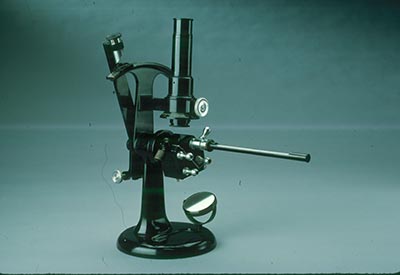From the Annals of NIH History
20 for 2020: Preserving the NIH in the 21st Century
If you wanted to outfit a laboratory as it may have looked in the late 1940s, we can help you. We helped Spark Media recreate a “typical” laboratory for their Partners of the Heart documentary on Alfred Blalock, Vivien Thomas, and Helen Taussig’s development of a surgical procedure to relieve a cyanotic heart defect—called cyanosis from Tetralogy of Fallot—saving the lives of “blue babies.” We provided the “antique lab equipment” including monocular microscopes, wood test-tubes racks, and even a typewriter. The NIH Stetten Museum has all that and more. (You can watch the movie at https://archive.org/details/PartnersOfTheHeart.)

CREDIT: MICHELE LYONS, OD
A lovely Bausch & Lomb Optical Co. Abbe Refractometer could be found in laboratories from the 1920s through the 1940s, and now in the NIH Stetten Museum collection. Let’s preserve our instruments from the 21st century too.
Maybe you want to recreate a laboratory from the 1990s. We could help a bit with that too. Thanks to a donation from the Office of Research Services’ Division of Scientific Equipment and Instrumentation Services, we received instruments helping to document the rise of genetics as a research tool at the NIH, such as an Applied Biosystems GeneAmp PCR System 9700 and a Perkin Elmer DNA Thermal Cycler 480. Remember them?
But if you wanted to know what was happening in biomedical research at NIH in the 21st century, well, we have the first DNA microarray printer at the NIH, which was designed and constructed at the National Human Genome Research Institute, as the core of a microarray collection.
And that’s pretty much it.
What instruments will museum curators use to explain your work to the public in 2040? How will historians of technology really know how instruments were designed and used if they can’t touch them? And if you win a Nobel Prize or a Lasker Award or a National Medal of Science, or even just the admiration and respect of your colleagues, how would your legacy be documented?
The NIH Stetten Museum is in a unique position to preserve the amazing developments of the 21st-century NIH, but it can’t do it without your help. So we’re looking to collect 20 representative scientific instruments during 2020. Some of the areas we’re looking to collect from are high-throughput technologies, imaging technology, 3-D printing, and the use of animals such as zebrafish. Computers and associated technology are also an important collecting area. We’re not worried about the size of an instrument or technology, because really big things can be documented in other ways.
What do you think we should be collecting to represent NIH’s work of the past 20 years? Do you have anything that fits what we’re looking for? Please let me know: Michele Lyons at lyonsm@od.nih.gov or 301-496-7695.
To learn more about the Office of NIH History and Stetten Museum, go to https://history.nih.gov.
This page was last updated on Tuesday, March 29, 2022
